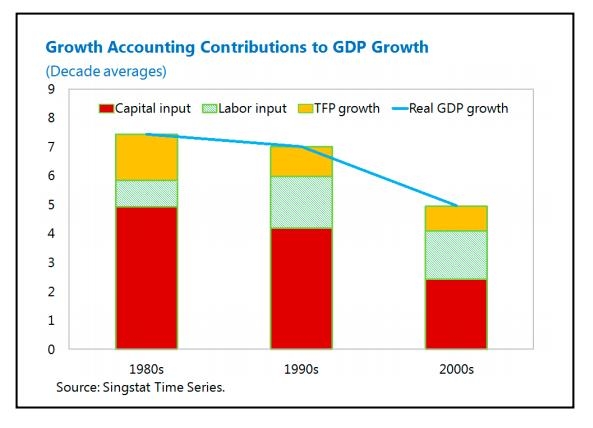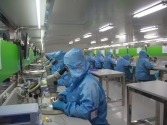
Why over-reliance on foreign workers is bad for the economy
Check out this graph showing the steady decline of total factor productivity to Singapore's GDP over the last 20 years.
To overcome domestic constraints on labor supply, Singapore has relied on large inflows of nonresident foreign
workers (NRFWs), who now account for about one-third of the labor force (including highly-skilled permanent residents, the share rises to 40 percent).
According to the International Monetary Fund, this is one of the highest shares in the world, with the exception of the Gulf countries. As a result, the multilateral agency said, that despite slow growth of the local working-age population, Singapore’s total labor force was among the fastest-growing in Asia during the past decade.
NRFWs are regulated through a system of levies and quotas (dependency ratio ceilings) differentiated by skill level and sector of activity, with less-skilled workers subject to higher levies and stricter rules.
As a share of employment, NRFWs have a very large presence in manufacturing and construction, but in absolute numbers, their presence is greatest in services (nearly half the total number, and thought to be predominantly in hospitality, domestic service, and retail).
Here are 3 macroeconomic implications according to IMF:
- Low productivity. The contribution of total factor productivity to GDP growth declined steadily during the previous two decades, while labor’s contribution to growth increased sharply. This may reflect that the large number of lessskilled workers obviated the need for efficiency-enhancingtechnologies and practices.
- Expand the wage distribution. International competition forhighly-educated professionals has aligned wages forforeigners and locals at the top-end of the income scale with those in other advanced economies. Meanwhile, recourse to the deep pool of less-skilled workers within Asia is thought to have pulled down the lower-end of Singapore’s wage distribution toward levels prevailing in source countries. Also, given the very large pool of lessskilled workers, the supply of this type of labor in Singapore is likely to be highly elastic, suggesting that wages for workers in these segments may not be very responsive to domestic conditions.
- Subdue inflation and real appreciation. Absorption of large numbers of less-skilled FWs in the nontradable sector restrained real unit labor costs, despite sizable wage increases in tradable sectors accompanied by large productivity gains. As a result, the path of the CPI-based real exchange rate was dampened.
























 Advertise
Advertise










